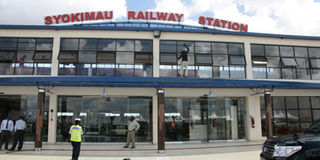Breaking News: Old Kijabe dam tragedy: Death toll rises to 45
Jam-free commuting prophesy fulfilled

Syokimau Railway Station on November 12, 2012. President Mwai Kibaki is expected to official open the station on November 13, 2012. Photo | BILLY MUTAI |
What you need to know:
- Syokimau Station is the first of its kind in Kenya, with electronic tickets that are swiped to open the turnstiles. Large screens at the platform announce departure times.
- Passengers will enjoy a more comfortable ride into the city centre as the old, cracked leather seats have been replaced with some comfortable green cushioned ones.
- Each coach can accommodate about 70 seated and 120 standing passengers, perhaps eliminating the crowding that forced some onto roofs and to hang from rickety doors.
- Motorists will be charged Sh300 — Sh200 for a two-way ticket and Sh100 for parking at the secure grounds.
- Commuters from estates off Mombasa Road and further south — Athi River, Kitengela, Syokimau and adjacent areas — should immediately begin to experience the comfort of an organised and regular train service.
Sometime in the 17th Century, a prophetess told her people what must have sounded least prophetic at the time.
Syokimau — for that was her name — spoke of the coming of a white man riding an iron snake with the legs of a centipede. He would have fire in his pockets — matches — and would speak like a bird — English.
The white man has since come and gone, and today, an iron snake will make its maiden journey from the station that bears her name.
Syokimau immortalised
She has been immortalised at the station where her statue stands, pointing Usain Bolt-like, at an iron snake suspended from the roof.
So significant is the event that President Kibaki and his entourage will be among the first to make a journey on the train from the station. The 16.5-kilometre ride into the city centre will be aboard a cream coach.
That should take 25 minutes. And while the distance can be a mere 15-minute drive on a good day, it can take two hours when traffic is bad, which it usually is on Mombasa Road.
After the commissioning, the presidential coach will be detached from the engine, and the train will begin to serve the public.
With the station’s construction and the laying of 2.2 kilometres of new railway tracks linking the station to the Nairobi-Mombasa line, the Syokimau station is a first in many ways.
The last station in Kenya was built in Butere, Western Kenya, 80 years ago. The last track was laid in 1901, when the Lunatic Express arrived at Port Florence, now called Kisumu.
Syokimau Station is the first of its kind in Kenya, with electronic tickets that are swiped to open the turnstiles. Large screens at the platform announce departure times.
Passengers will enjoy a more comfortable ride into the city centre as the old, cracked leather seats have been replaced with some comfortable green cushioned ones.
Each coach can accommodate about 70 seated and 120 standing passengers, perhaps eliminating the crowding that forced some onto roofs and to hang from rickety doors.
The station has space for cafes and shops as well as rest rooms. Escalators and a couple of lifts provide access to the upper floor, where more shops will be located.
Generators will kick in when Kenya Power goes AWOL, and a borehole has been sunk for constant supply of water.
The frequency of passenger trains on the route will double from the current one each way to two trips in the morning and another two in the evening.
In earlier interviews, Kenya Railways managing director Nduva Muli said the modern station will operate between 5am and 8 pm.
The trains, operated by Rift Valley Railways, will open their doors to the public tomorrow. A one-way ticket will cost Sh100.
Commuters from estates off Mombasa Road and further south — Athi River, Kitengela, Syokimau and adjacent areas — should immediately begin to experience the comfort of an organised and regular train service.
Changes at the Nairobi Railway terminus, currently congested and overpopulated by matatus, is part of the process to enable the train service to operate smoothly.
The station is considered important as the government implements a plan, long in coming, to make it easier to get in and out of Nairobi.
Its development is the first part of the joint project of the government and InfraCo, a project development company funded by donor agencies of the European Union. The deal was signed in on April 15, 2009.
The Syokimau stop has a parking lot for 2,500 vehicles. Motorists will be charged Sh300 — Sh200 for a two-way ticket and Sh100 for parking at the secure grounds.
This will make it possible for the operators to introduce the “park and ride” concept where motorists can leave their vehicles at the terminus and take the train into the city.
Kenya Railways acquired an additional 5.28 hectares (13.05 acres) earlier this year to increase the size of the parking lots.
Commuter upgrade
The parastatal is likely to use the experience from Syokimau to see how the rest of the Sh24 billion ($300 million) urban commuter upgrade will be implemented.
KR plans to develop a “core-system” covering 10 km and providing modern commuter rail services between Nairobi Railway Station and Ruiru, Embakasi, JKIA and Kikuyu.
Already, 17 companies are reported to have applied for the tender to lay the railway for the next phase of the Nairobi Urban Commuter Project.
The Sh24 billion commuter rail project has been divided into four phases, connecting the Central Business District (CBD) to Syokimau, Ngong, Kiserian Kikuyu and the Jomo Kenyatta International Airport.




